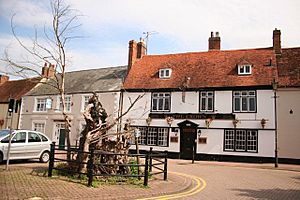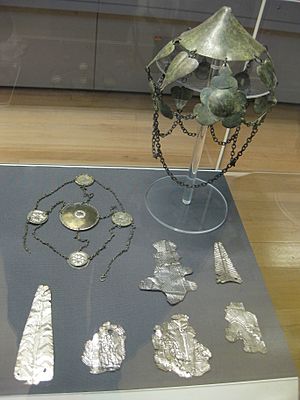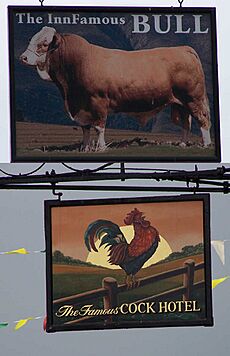Stony Stratford facts for kids
Quick facts for kids Stony Stratford |
|
|---|---|
 Market Place, Stony Stratford |
|
| Population | 7,736 (2011 Census) |
| OS grid reference | SP787404 |
| Civil parish |
|
| District |
|
| Unitary authority |
|
| Ceremonial county | |
| Region | |
| Country | England |
| Sovereign state | United Kingdom |
| Post town | Milton Keynes |
| Postcode district | MK11 |
| Dialling code | 01908 |
| Police | Thames Valley |
| Fire | Buckinghamshire |
| Ambulance | South Central |
| EU Parliament | South East England |
| UK Parliament |
|
| Website | https://www.stonystratford.gov.uk/ |
Stony Stratford is a lively market town in Buckinghamshire, England. It is part of the larger area known as Milton Keynes. This town sits right on Watling Street, which was once an important Roman road connecting London to Chester.
Stony Stratford is also a "civil parish," which means it has its own local government called a town council. It is located in the north-west part of Milton Keynes, close to Northamptonshire. The River Great Ouse forms a natural border there. In 2011, about 7,736 people lived in Stony Stratford.
Contents
A Look Back: Stony Stratford's Story
People have lived in Stony Stratford since at least Roman times. This was because it was a good place to cross the River Great Ouse on Watling Street. The town officially received its market rights in 1194. It became a recognized town in 1215.
What's in a Name?
The name "Stony Stratford" comes from Old English. It means "stony ford on a Roman road." The "road" is Watling Street, which goes right through the middle of the town. The "ford" (a shallow place to cross a river) was over the River Great Ouse. Today, a bridge helps people cross the river.
The Stony Stratford Hoard
In 1789, a special discovery was made near Stony Stratford. An old pot was found containing items like brooches and headdresses. This collection is known as the Stony Stratford Hoard. It also had about 30 silver pieces decorated with images of Roman gods like Mars, Apollo, and Victory. Some pieces even mentioned Jupiter and Vulcan. Experts believe these items might have been offerings to the gods at a Roman temple. You can see the hoard today at the British Museum.
Markets and Royal Connections
Stony Stratford has had a market since 1194, thanks to a special permission from King Richard I. For many years, farmers sold their animals in the market square. Now, the square is mostly a car park, but there's still a monthly farmers' market. The weekly market has moved to Timor Court. Stony Stratford officially became a town when King John gave it special permission in 1215.
In 1290, a cross called an Eleanor cross was built in Stony Stratford. It was a memorial to Queen Eleanor of Castile, who had recently passed away. Her funeral procession stopped in the town overnight on its way to London. Sadly, this cross was destroyed during the English Civil War.
A Prince's Stop
The old Rose and Crown Inn in Stony Stratford has a famous story. In 1483, the young king Edward V supposedly stayed there. He was on his way to London to become king after his father, Edward IV, died. However, his uncle, Richard, Duke of Gloucester, met him in Stony Stratford. Richard later took the throne himself, and Edward V became one of the Princes in the Tower. The inn is now a private home, but a plaque on the wall remembers this important event.
Fires and Travel
Stony Stratford has faced two big fires, in 1736 and 1742. These fires destroyed almost the entire town. The only building that survived the second fire was the tower of the chapel of ease of St Mary Magdalen. This tower is now a protected historical site.
For centuries, Stony Stratford was a key stop for travelers. It was on the main road to Ireland, which went through Chester. In the 16th century, the town became quite wealthy from this travel. During the 17th and 18th centuries, many coaching inns welcomed travelers using stage coaches. The road was so busy that England's first "turnpike trust" was set up in 1707 to help maintain it. By the early 1800s, over 30 mail and stage coaches stopped here every day!
However, this busy coach traffic ended suddenly in 1838. The London to Birmingham Railway opened nearby at Wolverton. This new railway made train travel much faster. Later, with the invention of the motor car, Stony Stratford became important again. Its location on the original A5 road made it a popular stopping point for drivers. In 1841, the town had a population of 1,757 people.
The "Cock and Bull Story"
Stony Stratford is famous for a local legend about the phrase a cock and bull story. This phrase means a story that is hard to believe. It is said to have started here because of two old hotels in the town center: The Cock and The Bull. Both were originally coaching inns on the main road between London and Chester.
Modern Stony Stratford
Today, Stony Stratford is still a busy and active market town. Every June, the town hosts Stony Live, a week of cultural events. This week ends with Folk on the Green, a free festival featuring folk music and other styles. It takes place on Horsefair Green.
Sports and Fun
Stony Stratford offers many sports and leisure activities for its residents.
Football
Stony Stratford Town F.C. is a local Non-League football club. It was started in 1898 and plays its games at Ostler's Lane.
Cricket
The Stony Stratford Cricket Club is an amateur cricket club, also founded in 1898. It is based at Ostlers Lane. The club has five senior men's teams and two women's teams that play in different leagues. They also have a junior section where younger players learn and compete.
Tennis
The Stony Stratford Lawn Tennis Club began in 1923 and is located at Ostler's Lane. The club has nine courts, and seven of them have lights for evening play. They also have a new clubhouse. Both men's and women's teams play in local leagues, and junior players compete in the Aegon Team Tennis League.
Bowls
The Stony Stratford Bowls Club was formed in 1923. They started playing at the current Ostler's Lane site in 1924. The club competes in the Bletchley and District Bowls League and won the league championship in 1994 and 2016.
Croquet
The Stony Stratford Croquet Club plays on the Ancell Trust Sports Grounds at Ostler's Lane. In 2016, the club won the East Anglian Croquet Federation's Handicap League.
Stony Stratford in Films
Some scenes from the 1987 movie Withnail and I were filmed in Stony Stratford. For example, Cox and Robinsons chemist shop became the "Penrith tea rooms" in the film. The Crown pub was used as the "King Henry pub." Both of these buildings are located on Market Square.
How the Town is Organized
Modern Parish
The modern "civil parish" of Stony Stratford was created in 2001. It includes the main town of Stony Stratford itself, plus two other areas: Galley Hill and Fullers Slade. This parish is managed by the town council.
Getting Around
Roads
Stony Stratford is no longer on a major national road. Watling Street still runs through the town, but the main A5 was moved twice in the past. Today, the A5, A422, and A508 roads meet about 1 mile north of Old Stratford. Local roads connect Stony Stratford to nearby towns like Fenny Stratford, Wolverton, and Winslow.
Trains
The closest train station is Wolverton, about 2 miles away. Only local trains stop there. For longer journeys, you can go to Milton Keynes Central, which is about 5 miles away and has faster trains.
From 1887 to 1926, a special tramway called the Wolverton and Stony Stratford Tramway connected Stony Stratford with Wolverton.
Buses
Bus route 6 (operated by Arriva) connects Stony Stratford to Wolverton, Central Milton Keynes, Bletchley, and the Lakes Estate. It runs about every 30 minutes on weekdays. Bus X60 (also by Arriva) connects the town to Aylesbury, Central Milton Keynes, and Crownhill.
The local council also offers an "on-demand" bus service called "MK Connect." This service covers the entire Milton Keynes area, including Stony Stratford.
Images for kids








